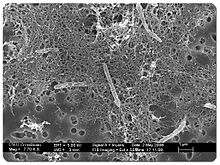- Desulforudis
-
Desulforudis audaxviator 
Desulforudis audaxviator Scientific classification Kingdom: Bacteria Phylum: Firmicutes Class: Clostridia Order: Clostridiaceae Family: Peptococcaceae Genus: Candidatus Desulforudis Species: Candidatus D. audaxviator Binomial name Desulforudis audaxviator Desulforudis audaxviator is a bacterium, which lives in depths from 1.5 km to 3 km below the Earth's surface in the groundwater.
It is the only bacterium found in water samples obtained 2.8 km underground in the Mponeng gold mine in South Africa. Approximately four micrometres in length, it has survived for millions of years on chemical food sources that derive from the radioactive decay of minerals in the surrounding rock, making it one of the few organisms known that does not depend on sunlight for nourishment and the only species known to be alone in its ecosystem.[1] D. audaxviator has genes for extracting carbon from dissolved carbon dioxide and for nitrogen fixation. It may also have acquired genes from a species of archaea by horizontal gene transfer.[2]
They have been isolated from Earth's surface for several million years, because analyses of the water that they live in showed that it is very old and has not been diluted by surface water. Because the environment at that depth is so much like the early Earth, it gives a handle on what kind of creatures might have existed before there was an oxygen atmosphere. Billions of years ago, some of the first bacteria on the planet may have thrived in similar conditions. The newly discovered microbes could shed light into the origins of life on Earth.
D. audaxviator is a Gram positive sulfate-reducing bacterium (making it the first complete such genome). The genome contains an unusual transposon and possesses many sites of insertion. Loss of complete oxygen tolerance system suggests long-term isolation. The hydrocarbons in that environment do not come from living organisms. The source of the hydrogen needed for their respiration comes from the decomposition of water by radioactive decay of uranium, thorium, and potassium. The radiation allows for the production of sulphur compounds that these bacteria can use as a high-energy source of food.
The name comes from a quotation from Jules Verne's novel Journey to the Center of the Earth. The hero, Professor Lidenbrock, finds a secret inscription in Latin that reads: Descende, audax viator, et terrestre centrum attinges (Descend, bold traveller, and you will attain the center of the Earth).[1]
Contents
See also
- List of sequenced archeal genomes
- AngloGold Ashanti, operator of the Mponeng gold mine
Notes
- ^ a b Eliza Strickland. "Deep in a Goldmine, an Ecosystem of One". Discover magazine. http://blogs.discovermagazine.com/80beats/2008/10/10/deep-in-a-goldmine-an-ecosystem-of-one/. Retrieved 2008-10-10.
- ^ Catherine Brahic. "Goldmine bug DNA may be key to alien life". New Scientist. http://environment.newscientist.com/channel/earth/dn14906-goldmine-bug-dna-may-be-key-to-alien-life.html?feedId=online-news_rss20. Retrieved 2008-10-11.
References
- Dylan Chivian, Eoin L. Brodie, Eric J. Alm, et al. "Environmental genomics reveals a single-species ecosystem deep within the Earth,", Science, 10 October 2008 doi:10.1126/science.1155495
- "At 2.8 km down, a 1-of-a-kind microorganism lives all alone" Physorg 2008-10-09
External links
Categories:- Bacteria
- Sulphophiles
- Barophiles
- Lithophiles
- Monotypic bacteria genera
- Bacteria described in 2008
Wikimedia Foundation. 2010.
